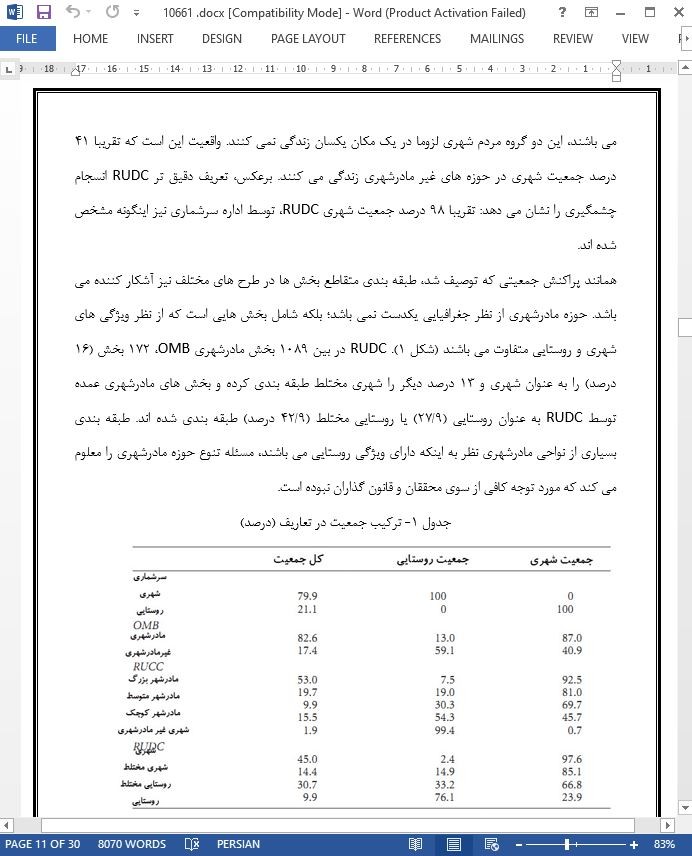
تفاوت های فضایی در فقر ایالات متحده
چکیده
از آنجا که فقر در نواحی روستایی و شهری ایالات متحده اغلب دارای دلایل، روابط و راه حل های متفاوتی می باشد، سیاست های ضد فقر موثر بستگی به درک کامل روستایی یا شهری بودن یک مکان خاص دارند. این مقاله چندین طرح طبقه بندی که به فراوانی مورد استفاده قرار گرفته اند و اندازه های متفاوت فقری را که در ایالات متحده نشان داده اند را مقایسه می کند. تمایز "مادر شهری، غیر مادر شهری" که معمولا مورد استفاده قرار می گیرد، تفاوت های اجتماعی اقتصادی مهم بین نواحی مادرشهری را نامفهوم ساخته و فهم ما از جغرافیای فقر را مبهم می کند. با توجه به تعداد و تمرکز مردم فقیری که در بخش های روستایی مختلط (mixed rural) و روستایی مناطق مادرشهری زندگی می کنند، محققان و قانون گذاران باید توجه خاصی به فرصت ها و محدودیت هایی که این افراد با آن رو به رو هستند داشته باشند. طبقه بندی متقاطع سیستم مادرشهری دفتر مدیریت و بودجه (OMB) همراه با یک طرح دقیق RUDC موثرترین راه برای نشان دادن پیچیدگی های جغرافیایی فقر در داخل حوزه های مادرشهری می باشد.
1- مقدمه
عبارات city، urban و metropolitan در پژوهش و سیاست اغلب به جای همدیگر به کار می روند. یک ماه بعد از به دست گیری قدرت، دولت اوباما دفتر امور شهری کاخ سفید را تاسیس کرد که وظیفه اش ایجاد راهبردی برای آمریکای مادرشهری و تضمین مصرف تمامی بودجه اختصاص داده شده به نواحی شهری در برنامه های موثر می باشد. بنابراین، حتی در بالاترین رده های دولت نیز عبارات شهر و مادر شهر باهم تلفیق شده اند. در حالی که سرمایه گذاری در مناطق مادرشهری برای رفاه اقتصادی بلند مدت ایالات متحده حیاتی می باشد، چنین تاکیدی بر مادرشهر می تواند درک دقیق از تفاوت های اجتماعی اقتصادی مکان های داخل حوزه های مادرشهری را مبهم سازد.
5- بحث و نتیجه گیری
بسته به تعاریف به کار رفته، ایالات متحده می تواند به عنوان عمدتا شهری یا بیشتر روستایی نشان داده شود. جمعیت روستایی از تقریبا دو درصد کل جمعیت (تعریف RUCC) تا بیش از 20 درصد قابل تغییر است (تعریف اداره سرشماری). جمعیت شهری میتواند به کوچکی 45 درصد (تعریف RUDC) یا به بزرگی 83 درصد (تعریف OMB) باشد. این تفاوت ها به تفاوت های تخمین بافت شهری و روستایی فقر منجر می شوند. طبق تعریف اداره سرشماری از شهر، تقریبا 28 میلیون نفر از ساکنین شهری فقیر می باشند. در حالی که طبقه بندی RUDC نشان می دهد که تنها 15 درصد ساکنین شهری فقیر می باشند. دوگانه کردن شهر و روستا، پیچیدگی و تنوع مکان های شهری و روستایی را پنهان می کند. اکثر بخش های مادرشهری (71 درصد) مکان های روستایی یا روستایی مختلط هستند. یافته های ما با این عقیده عمومی که حوزه های مادرشهری و یا شهری در رابطه با فقر و شاخص های اجتماعی اقتصادی وضعیت بهتری نسبت به حوزه های غیر مادرشهری و روستایی دارند، هماهنگ می باشد اما پیچیدگی و تنوع چشمگیری در مکان های شهری و روستایی وجود دارد. در حوزه های غیر مادرشهری، بخش های روستایی مختلط در مقایسه با بخش های روستایی، فقر کمتری دارند. در حوزه های مادرشهری، بخش های روستایی مختلط، شهری و روستایی در رابطه با فقر و شاخص های اجتماعی اقتصادی دیگر کاملا متفاوت با بخش های شهری مختلط می باشند. بخش های شهری مختلط نسبت به هر دو بخش روستایی تر و شهری تر وضعیت بسیار بهتری دارند. این نکات ظریف، جغرافیای فقر مادرشهری را به تصویر می کشد که گسترش یافته و موجب ترکیب آمیزش کارکردهای شهری و روستایی شده است.
Abstract
Because poverty in rural and urban areas of the US often has different causes, correlates and solutions, effective anti-poverty policies depend on a thorough understanding of the ruralness or urbanness of specific places. This paper compares several widely used classification schemes and the varying magnitudes of poverty that they reveal in the US. The commonly used ‘metropolitan/non-metropolitan’ distinction obscures important socioeconomic differences among metropolitan areas, making our understanding of the geography of poverty imprecise. Given the number and concentration of poor people living in mixed-rural and rural counties in metropolitan regions, researchers and policy-makers need to pay more nuanced attention to the opportunities and constraints such individuals face. A cross-classification of the Office of Management and Budget’s metro system with a nuanced RUDC scheme is the most effective for revealing the geographical complexities of poverty within metropolitan areas.
1. Introduction
The terms city, urban and metropolitan are often used interchangeably in research and policy. Within one month of taking office, the Obama administration established a White House Office of Urban Affairs whose charge is to to urban areas are effectively spent on the highest-impact programmes (The White House, 2009; emphasis added). Thus, even at the highest levels of government, the terms urban and metropolitan are conflated. While investments in metropolitan areas are vital to the US’ long-term economic well-being (Katz et al., 2009), such a metropolitan emphasis can cloud a nuanced understanding of the socioeconomic diversity of places within metropolitan areas.
5. Conclusion and Discussion
Depending on the definition employed, the US can be depicted as largely urban or more rural. The rural population ranges from about 2 per cent of total population (RUCC definition) to more than 20 per cent (Census Bureau definition). The urban population can be as low as 45 per cent (RUDC definition) or as high as 83 per cent (OMB definition). These differences translate into differences in estimation of the urban and rural context for poverty. Under the Census Bureau urban definition, about 28 million urban residents are poor, while the RUDC classification suggests that only around 15 million urban residents are poor. Dichotomising rural and urban masks the complexity and diversity of rural and urban places. Most metro counties (71 per cent) are rural and mixed rural places. While our findings are consistent with the conventional wisdom that metro or urban areas fare better than non-metro or rural areas in terms of major poverty and socioeconomic indicators, there is considerable complexity and diversity within rural and urban places. In non-metro areas, mixed rural counties are less poor than rural counties. Within metro areas, mixed rural, urban and rural counties are quite different from mixed urban counties with respect to poverty and other major socioeconomic indicators. Mixed urban counties fare the best relative to either the more rural or more urban counties. These nuances capture the geography of metropolitan poverty that increasing sprawl and the mixing of urban and rural functions have spawned.

چکیده
1- مقدمه
2- بررسی تعاریف و طرح های طبقه بندی روستایی شهری
1-2 شهر و روستا: تعریف اداره سرشماری ایالات متحده
2-2 مادرشهری و غیر مادرشهری: طبقه بندی ارائه شده توسط OMB
3-2 کد همبستگی روستایی شهری (RUCC)
4-2 کد تراکم روستایی شهری (RUDC)
5-2 تفاوت در ترکیب جمعیت و توزیع بخش در تعاریف
3- مواد و روش ها
4- تفاوت ها در نمایش فقر شهری و روستایی
1-4 تنوعات فقر در تعاریف
2-4 تنوع فقر در بخش های طبقه بندی شده به صورت ناسازگار (متباین)
3-4 تفاوت های منطقه ای در تاثیر تعاریف شهری- روستایی
5- بحث و نتیجه گیری
Abstract
1. Introduction
2. A Review of Rural Urban Definitions and Classification Schemes
2.1 Urban and Rural: US Census Bureau Definition
2.2 Metropolitan and Non-metropolitan: The OMB Classification
2.3. The Rural Urban Continuum Code (RUCC)
2.4 The Rural Urban Density Code (RUDC)
2.5 Variation in Population Composition and County Distribution across Definitions
3. Data and Method
4. Variations in the Representation of Urban and Rural Poverty
4.1 Variations in Poverty across Definitions
4.2 Poverty Variation in Inconsistently Classified Counties
4.3 Regional Variations in the Impact of Urban–rural Definitions
5. Conclusion and Discussion
- اصل مقاله انگلیسی با فرمت ورد (word) با قابلیت ویرایش
- ترجمه فارسی مقاله با فرمت ورد (word) با قابلیت ویرایش، بدون آرم سایت ای ترجمه
- ترجمه فارسی مقاله با فرمت pdf، بدون آرم سایت ای ترجمه
